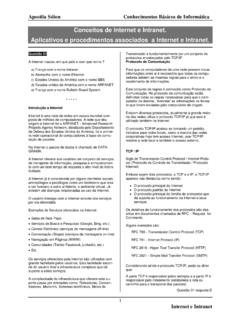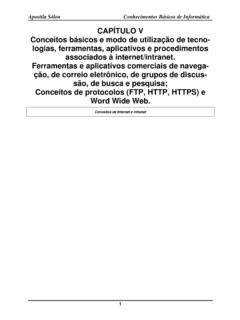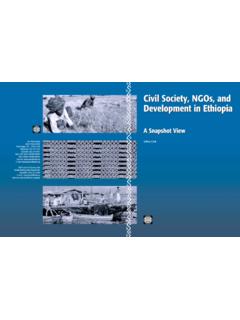Transcription of E-Government and E-Governance: …
1 E-Government and E-Governance: Definitions/Domain Framework and Status around the World Shailendra C. Jain Palvia1* and Sushil S. Sharma2 ABSTRACT E-Government refers to the delivery of national or local government information and services via the Internet or other digital means to citizens or businesses or other governmental agencies. E-Government is a one-stop Internet gateway to major government services. E-Government facilitates provision of relevant government information in electronic form to the citizens in a timely manner; better service delivery to citizens; empowerment of the people through access to information without the bureaucracy; improved productivity and cost savings in doing business with suppliers and customers of government ; and participation in public policy decision-making.
2 E-Governance refers to how managers and supervisors utilize IT and Internet to execute their functions of supervising, planning, organizing, coordinating, and staffing effectively. Keywords: E-Government , e-Governance, Domain Framework, Inter-Organizational Systems, Manager Functions 1. E-Government Definitions E-Government is a generic term for web-based services from agencies of local, state and federal governments. In E-Government , the government uses information technology and particularly the Internet to support government operations, engage citizens, and provide government services.
3 The interaction may be in the form of obtaining information, filings, or making payments and a host of other activities via the World Wide Web (Sharma & Gupta, 2003, Sharma, 2004, Sharma 2006). E-Government is defined by other sources as follows: World Bank ( ) definition (AOEMA report): E-Government refers to the use by government agencies of information technologies (such as Wide Area Networks, the Internet, and mobile computing) that have the ability to transform relations with citizens, businesses, and other arms of government .
4 These technologies can serve a variety of different ends: better delivery of government services to citizens, improved interactions with business and industry, citizen empowerment through access to information, or more efficient government management. The resulting benefits can be less corruption, increased transparency, greater convenience, revenue growth, and/or cost reductions. United Nations ( ) definition (AOEMA report): E-Government is defined as utilizing the Internet and the world-wide-web for delivering government information and services to citizens.
5 1 Long Island University, Brookville, New York 11548, USA 2 Ball State University, Muncie, Indiana, USA * Corresponding Author: (Email: Telephone: 516-498-7214) 1 Foundations of E-Government Global Business Dialogue on Electronic Commerce - GBDe ( ) definition (AOEMA report): Electronic government (hereafter E-Government ) refers to a situation in which administrative, legislative and judicial agencies (including both central and local governments) digitize their internal and external operations and utilize networked systems efficiently to realize better quality in the provision of public services.
6 Gartner Group s definition: the continuous optimization of service delivery, constituency participation, and governance by transforming internal and external relationships through technology, the Internet and new media. Definition of the Working Group on E-Government in the Developing World ( ): E-Government is the use of information and communication technologies (ICTs) to promote more efficient and effective government , facilitate more accessible government services, allow greater public access to information, and make government more accountable to citizens.
7 E-Government might involve delivering services via the Internet, telephone, community centers (self-service or facilitated by others), wireless devices or other communications systems. While definitions of E-Government by various sources may vary widely, there is a common theme. E-Government involves using information technology, and especially the Internet, to improve the delivery of government services to citizens, businesses, and other government agencies. E-Government enables citizens to interact and receive services from the federal, state or local governments twenty four hours a day, seven days a week.
8 E-Government is in the early stages of development. Most governments have already taken or are taking initiatives offering government services online. However, for the true potential of E-Government to be realized, government needs to restructure and transform its long entrenched business processes. According to Gartner, E-Government involves the use of ICTs to support government operations and provide government services (Fraga, 2002). However, E-Government goes even further and aims to fundamentally transform the production processes in which public services are generated and delivered, thereby transforming the entire range of relationships of public bodies with citizens, businesses and other governments (Leitner, 2003).
9 In the last few years, there has been much talk of mobile government or m- government . M- government refers to the use of wireless technologies like cellular/mobile phones, laptops and PDAs (Personal Digital Assistants) for offering and delivering government services. M- government is not a substitute for E-Government , rather it complements it. 2. E-Governance Definitions E-governance, meaning electronic governance is using information and communication technologies (ICTs) at various levels of the government and the public sector and beyond, for the purpose of enhancing governance (Bedi, Singh and Srivastava, 2001; Holmes, 2001; Okot-Uma, 2000).
10 According to Keohane and Nye (2000), Governance implies the processes and institutions, both formal and informal, that guide and restrain the collective activities of a group. government is the subset that acts with authority and creates formal obligations. Governance need not necessarily be conducted exclusively by governments. Private firms, associations of firms, nongovernmental organizations (NGOs), and associations of NGOs all engage in it, often in association with governmental bodies, to create governance; sometimes without governmental authority.







